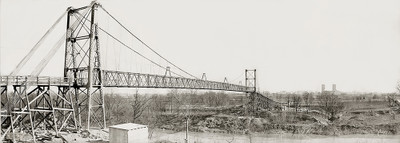 Loading... Please wait...
Loading... Please wait...OHV - Swinging Bridge
Sorry but this item is currently unavailable.
Please check back at a later stage.
Product Description
Swinging Bridge
Digitally restored photo printed on metal, 41" wide x 14" high, ready to hang.
When construction work began on the world’s largest gunpowder manufacturing facility in Jacksonville, Tennessee (now Old Hickory), the only means for crossing the Cumberland River to the west was an old county ferry boat known as "Edgefield." Hundreds of people came to the plant daily by this route, and much material was also conveyed across the river on this boat. The Edgefield was not of sufficient capacity to handle the traffic, which increased daily, and other boats were put in operation. Still, the traffic was too heavy for these boats. Ferry service was slow, and it was evident better accommodations were necessary. A pontoon bridge was put into service in August of 1918. Frequently, the pontoon bridge was out of service due to high water. The number of workers crossing the river, sometimes 5,000 a day in August and September, begged for improvement. Construction soon began on what would become the most expensive piece of work constructed for the WWI effort, a suspension bridge. Built by the American Bridge Company, the bridge was 8 feet wide and designed to accommodate automobiles and pedestrians. Suspended by fourteen heavy cables attached to towers on either side of the river, the main span was 540 feet in length, and the floor of the bridge was 90 feet above normal water level. The bridge was notorious for its rattling-boarded floor and swaying motion. It was put into service at the end of November 1918 and remained in service until 1928. The bridge was deconstructed and sent to South America.
Call Picture This for pricing. 615-889-5640


